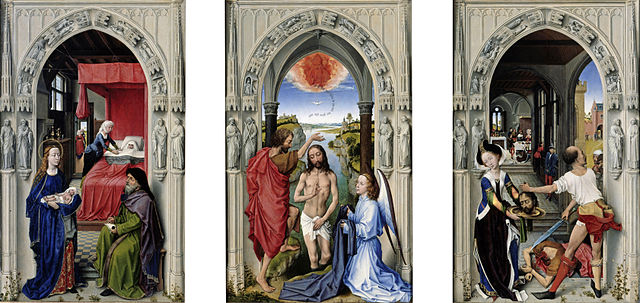The Miraflores Altarpiece is a c. 1442-5 oil-on-oak wood panel altarpiece by the Early Netherlandish painter Rogier van der Weyden, in the Gemäldegalerie, Berlin since 1850. The three panels are each 71 x 43 cm and show, from left to right, a portrait of the Holy Family, a Pietà and Christ's appearance to Mary—a chronological reading of the birth, death and resurrection of Jesus, with Mary the focus of both wings. The altarpiece examines Mary's relationship with Christ at different stages of his life. It is notable for its use of colour, distinguished by its use of whites, reds and blues, and use of line—notably the line of Christ's body in the central panel—and, typically of van der Weyden, its emotional impact.
Van der Weyden's c. 1455 Altar of Saint John. Gemäldegalerie, Berlin. This triptych is linked to the Miraflores in its shared symbolic motifs, most notably the winding pathway, doorway and perspective tiles.
Posthumous portrait of Queen Isabel of Castile. Her father John II knew Jan van Eyck who had died by the time the painting was commissioned. Instead John enlisted van der Weyden. It is believed that Isabel was so impressed by the work that she in turn commissioned a copy (now in New York) from a member of van der Weyden's workshop or a follower.
Image: Rogier van der Weyden The Altar of Our Lady (Miraflores Altar) Google Art Project (left panel without frame)
Image: Rogier van der Weyden The Altar of Our Lady (Miraflores Altar) Google Art Project (center panel without frame)
Rogier van der Weyden or Roger de la Pasture was an early Netherlandish painter whose surviving works consist mainly of religious triptychs, altarpieces, and commissioned single and diptych portraits. He was highly successful in his lifetime; his paintings were exported to Italy and Spain, and he received commissions from, amongst others, Philip the Good, Netherlandish nobility, and foreign princes. By the latter half of the 15th century, he had eclipsed Jan van Eyck in popularity. However his fame lasted only until the 17th century, and largely due to changing taste, he was almost totally forgotten by the mid-18th century. His reputation was slowly rebuilt during the 200 years that followed; today he is known, with Robert Campin and van Eyck, as the third of the three great Early Flemish artists, and widely as the most influential Northern painter of the 15th century.
Rogier van der Weyden
Imaginative portrait by Cornelis Cort, 1572
The Descent from the Cross (c. 1435), oil on oak panel, 220 × 262 cm. Museo del Prado, Madrid
Portrait of a Woman with a Winged Bonnet, c. 1440. Gemäldegalerie, Berlin.








